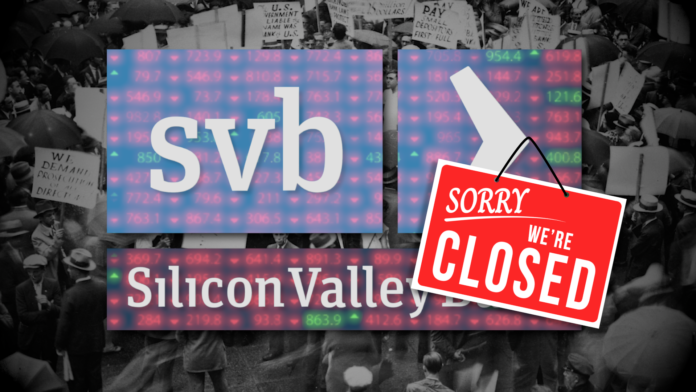In March, Silicon Valley Bank and Signature Bank became the second and third-largest banks ever to fail in U.S. history. Both banks, as well as Silvergate Bank, took just five days to collapse. This sent panic that rippled throughout the economy.
Signature Bank was popular within the cryptocurrency community. Silicon Valley Bank (SVB) was the 16th largest bank in the country and like Silvergate, had depositors who were heavily involved in the technology industry.
SVB’s deposit base tripled between 2020 and 2022 and they earned billions of dollars through the loans they gave to startup tech companies, but how they handled this financial success eventually led to their downfall.
What makes the banks so fragile?
Kris Mitchener, economics professor at Santa Clara University and research associate at the National Bureau of Economic Research says, “Banks are fragile because of their business model.”
Banks use depositors’ money to make investments. They use those returns as well as interest from loans they give to individuals and businesses to cover their expenses and eventually profit.
This business model is fragile because banks need a lot of money on hand should their depositors need it, but they often utilize risky investments to turn profits. If the banks take a loss on those investments when the depositors need money they then risk bankruptcy.
Most banks have depositors from a variety of industries, so if one industry falls on hard times, they still have depositors from other industries giving them money to keep the bank running.
Mitchener explains that in SVB’s case, almost all of their depositors were from the tech sector – a historically volatile field – and exceeded the Federal Deposit Insurance Corporation’s (FDIC) $250,000 insurance limit.
The impact of rising interest rates
Knowing that SVB lacked variety in their depositor base and seeing that they had a plethora of uninsured accounts, SVB tried to minimize risk by taking their new earnings and investing them into government bonds – considered to be one of the least risky investments around.
What they didn’t consider was the double-sided disaster rising interest rates would cause. As interest rates rose, depositors across the tech industry needed to withdraw their money to cover the increase in the cost of the debt they used to start their untested ventures.
Those withdrawals picked up pace after Silvergate Bank collapsed on March 8. Depositors who saw similarities between Silvergate and SVB rushed to remove their funds and liquidate accounts.
Most of SVB’s clients had multi-million or even billion-dollar accounts, and when they went to take their money out, it wasn’t there. The bank needed the money it invested in those 10-year treasury bonds to pay its depositors and remain solvent.
When SVB made those investments, interest rates were incredibly low. By the time they cashed out their bonds to pay depositors, interest rates were much higher, erasing the bonds’ value.
Lost money means lost customers
SVB lost about $1.8 billion selling those bonds, intensifying the panic and sending customers into a full-blown bank run the likes of which haven’t been seen since the Great Depression.
“One day you think banks are healthy and the next day you wake up and you think they’re insolvent. When those beliefs coordinate on that new equilibrium where you think the bank is insolvent, then people run those banks and those runs can happen really quickly. We saw the same thing in 1929,” Mitchener told Crash Proof Retirement and discussed further in his paper, “Arresting Banking Panics: Federal Reserve Liquidity Provision and the Forgotten Panic of 1929.”
After the run, SVB’s shares tumbled 50% in one day, its steepest single-day drop ever. SVB quickly collapsed on March 10, leaving depositors who didn’t run the bank stranded.
Depositors involved in these recent bank failures far surpassed the FDIC’s
$250,000 limit, but this time, the FDIC made depositors whole.
“[The FDIC was] concerned about the risks, people waking up to these risks, and starting to run other banks who have similar characteristics,” Mitchener says as to why the FDIC assisted depositors.
All of this shows that banks take more risk than we thought and large sums of money were never safe – not even government bonds were truly guaranteed. The sad reality is that this is poised to happen again.
How is this allowed?
After a similar rush of bank runs fueled the Great Depression, the Glass-Steagall Act was passed in 1933. This created the FDIC, limited the investment risks banks could take, and led to decades of tranquility in the banking sector. But in 1999, former President Bill Clinton repealed the act.
Now banks can take risks to increase their profit and if those investments fail the FDIC is your only protection. If your deposits surpass the FDIC’s insurance limit, you’re out of luck. If the Glass-Steagall Act was still in place, this wouldn’t happen.
SVB’s failed investments are a prime example of exactly what the Glass-Steagall Act was trying to prevent. Confidence in the safety of banks is essential to keeping the economy running. Failing to maintain that confidence has caused some of the greatest market crashes in history, and it all stemmed from failed investments made by banks.
What impact will this have going forward?
The recent FDIC bailouts helped stabilize consumer panic, but unfortunately, the FDIC can’t continue to bail out banks much longer.
Ross Levine, the Willis H. Booth chair in Banking and Finance at the University of California, noted that it’s possible the FDIC will have to borrow money to pay for this round of bailouts.
While the FDIC is not tax-payer funded, loans from the U.S. Treasury are. If the FDIC does borrow money to cover its bailouts, it’ll be printed by the Federal Reserve, leaving hardworking taxpayers to foot the bill.
If a bank isn’t safe, then what is?
The bottom line is that bank safety is a facade. Since the repeal of the Glass-Steagall Act, banks aren’t as safe as they once were.
Bank failures are just one of the many things that could crash the markets, but what’s more concerning for those who worked a lifetime is that the investments they once thought were safe are no longer.
Only investments in the financial life insurance industry are proven, through all market crashes and bank failures in history, to protect every penny of investors’ money and allow them access to their funds when they need it. The licensed consumer advocates at Crash Proof Retirement are experts in these under-utilized safe alternatives and will customize a system around your goals to guarantee the retirement dream you worked so hard for.
If you would like to learn more about The Proprietary Crash Proof Retirement System call 1-800-722-9728 or fill out the online form on our contact page https://crashproofretirement.com/crash-proof-retirement-contact/.













